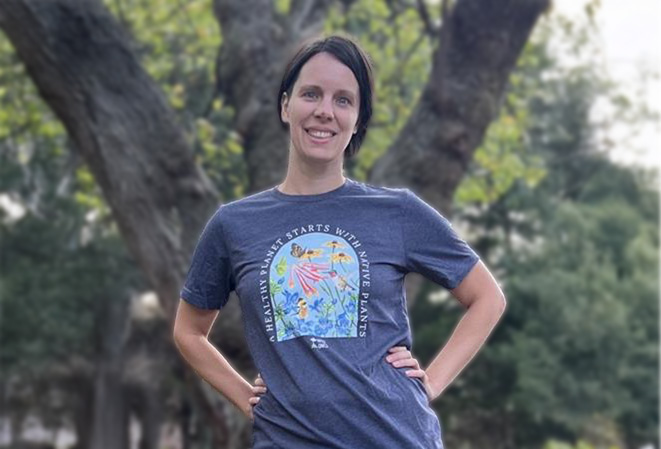Have you ever stopped to consider the power and influence we have over the world? Not just with regard to the climate; consider the fact that we’re able to take seeds, plants, trees, move them across continents and force them to exist in entirely new ecosystems. The lands that we’re manipulating are the result of incomprehensible geologic amounts of time to form their adaptations, and here we come making tropical maize plants grow in Canada, or boreal blueberries in Florida. Regardless of whether you believe in a god, we should absolutely acknowledge that we have taken a godlike role in shaping our surroundings. It’s a fearsome position to be in and there have been more than a fair share of warnings about this kind of power throughout human history.
In Greek myth there is a persistent theme of intermingling the affairs of god and man, almost always to some devastating result, and the story of Hyacinth is no different. Hyacinthus was a legendary Spartan prince who fell in love with the god Apollo and was also admired by the wind gods Boreas and Zephyrus. In a game of discus between Apollo and Hyacinthus the discus was thrown with a deific force and killed Hyacinthus. There being no way to revive him, Apollo created a flower in his memory to forever remember him: the hyacinth. Though that flower was probably Scilla bifolia (Lindsell, 1937). Some tellings of the story claim it was Zephyrus who was jealous and had altered the discus’ path, but to make this story even more poignant, Hyacinthus was actually an even more ancient nature deity that represented spring ephemerality and vegetation (Encyclopædia Britannica). So not only is this a story of the treacherous attempts to exist alongside the gods, it’s also a story of the literal killing of a culture’s old respect for nature.
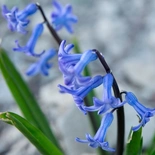
Garden Hyacinth(Hyacinthus orientalis)
The hyacinth as we know it today is Hyacinthus Orientalis (Commonly called garden hyacinth, dutch hyacinths, or common hyacinth). They’re native to Southwest Asia and their range includes modern-day Lebanon, Turkey, and Palestine (Plants of the World Online). It’s a member of the Asparacaeae family and if you’ve never seen one, it’s an herbaceous perennial that grows from a bulb and has a base of waxy, narrow, semi-succulent leaves. They curve inward lengthwise and come to a point at the top and look almost like a shoe horn or a cathorn trowel. This crown of trowels is bestowed onto a single thick green scape that comes to about three to four inches before presenting these incredible blue flowers like peeled bananas all arranged like sleigh bells on the end of the scape. These days they come in far more colors than blue. In our continued hubris we can also force them to bloom at any time of year.
The hyacinth became a popular flower in North America in much the same way as all the other major commercial successes. We all wanted to copy the foreign aristocracy. The hyacinth was introduced to Europe a long time ago, but became a recent horticultural fad in France and the Netherlands in the 18th century (Hyacinth History). This was also the time period in which the United States colonies started their cultural construction, and it was all too common to borrow the trends from the original countries from which the colonists had all come. And yet again, it stuck, and nobody had ever seemed to question it since. I hope that we all start to question these things as we stand at the ledge of a major ecological crisis. We’ve played god by bringing these flowers across the ocean, and we’ve filled countless altered landscapes with them when there are perfectly adequate substitutes that are native to North America. They fill a class of spring plants that are especially vulnerable here, and the following examples are just a few ways we can set things right by replacing the hyacinth in American gardens.
Wild Hyacinth (Camassia spp.)
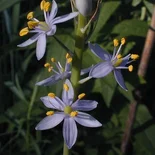
Prairie Camas(Camassia angusta)
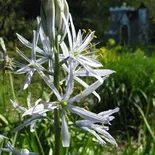
Cusick's Camas(Camassia cusickii)
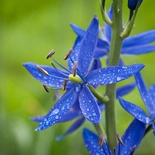
Howell's Camas(Camassia howellii)
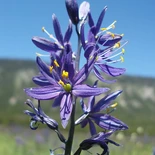
Large Camas(Camassia leichtlinii)
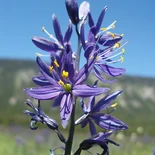
Small Camas(Camassia quamash)
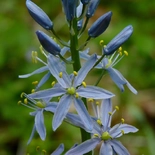
Atlantic Camas(Camassia scilloides)
Nothing would be more appropriate to replace the hyacinth than a flower of North America commonly called the “Wild Hyacinth,” or “Quamash” as it is known among some Indigenous peoples. Several species of Camassia span the entire United States with a small gap in the central dry regions. Though this is in the same family as the hyacinth, the genus is entirely different. Regardless, this is the closest native herb in form to the traditionally grown Mediterranean hyacinth, and some species match the blue that many are used to out of the commercial Hyacinth. There are also species that bear white and purple inflorescences.
The plant has a unique cultural significance in the United States as an indigenous food source (Jette, 2004). The bulb is edible and continues to be cultivated as a food crop in more niche farms. This definitely has potential in the future to be cultivated for other traits like aesthetics or increased foliage size but, like all domestications, will take a long time. Cultivating this is important as North America used to be home to camas prairies that have since been eradicated for homesteads and ranches during westward expansion, no doubt a systematic attempt to remove indigenous food sources similar to the bison near-extinction.
Currently, many species of Camassia are available from native plant nurseries, and you can buy them as seeds or bulbs. Starting from seed is slightly more challenging due to a very long cold stratification period, but the results are worth it. The flower attracts all types of insects and is a preferred species of Merodon equestris, a species of hoverfly. This goes for other food references here, but forage responsibly, and note that there is a toxic native lookalike, Toxicoscordion venenosum, charmingly called the “death camas.”
Yellow Trout Lily (Erythronium americanum)
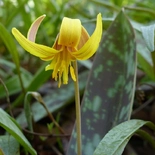
Yellow Trout Lily(Erythronium americanum)
The wild hyacinth is not actually a spring ephemeral. It’s not always the case that there is a perfect one-to-one species match across a vast ocean. Erythronium americanum will be an example of matching the spring ephemeral interest of the Hyacinth, but share virtually none of the features that someone would like in the Hyacinth. The flower that is commonly called the “American trout lily” is in the family Liliaceae and is as common in the eastern woodlands as daffodils, hyacinths, and tulips are in suburban gardens. It sports two wide strikingly patterned leaves and its namesake is due to bearing some resemblance to trout (Plant database, n.d.); though the resemblance is frankly more like a DIY black camo that some people like to put on their matte green vans. The bright yellow flowers will be incredibly familiar to the casual gardener because it’s a lot like any other common garden lily. In a lot of ways this is the most compelling candidate for those interested in replacing a hyacinth because of how common daffodils and lilies already are in gardens. Generally someone looking for hyacinth is also looking for other spring flowers in the same genre. This would seem to fit the bill.
Erythronium americanum is available in native plant nurseries as seed or live plants. Aim for propagating by bulb because they take many years to flower. It grows in forest understories, so ensure there’s partial sun, but full shade can work as well. It’s also hardy from zones 3-8.
Virginia Bluebells (Mertensia virginica)
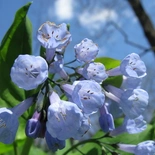
Virginia Bluebells(Mertensia virginica)
Another incredible spring ephemeral of the family Boraginaceae has the common name of Virginia bluebells. Again, we’re talking about a plant that doesn’t resemble the hyacinth much, aside from having clusters of flowers. It does, however, share the striking blue color that many hyacinths have and develops early in the spring. The flower is a gift to animals. The scapes rise out from oval foliage that look like clumps of baby leaf lettuce. They are adorned with numerous little blue flowers like long handled bells or like small blue ball gowns and they feed hummingbirds, moths, butterflies and the list goes on (Virginia bluebells, mertensia virginica). They grow closer to the ground and tend more towards forest understories. They are hardy to zones 3-9 and form tight colonies.
Cultivating Mertensia is important. Habitat loss has led to its status as threatened. Fortunately, they can be acquired through the usual national native plant nurseries. They will take a couple of years to bloom like many perennial natives, so plan carefully and, like the hyacinth, they’ll also go dormant in the summer.
Conclusion
Spring ephemerals are a vulnerable class of plants. The brief life cycle means that other faster spreading plants can easily box out the competition. We have already dealt with numerous invasives in the United States in the spring. The garden is a chance for individuals to use our enormous powers of ecological change for the sake of reviving spring ephemerals lost to either private development or our sordid history. The hyacinth is a living symbol of the Hellenic tragedy. We killed the old gods and replaced them with new, perfectly manicured, trendy ones. The hyacinth has a ubiquity to the point where they are sold in bundles with daffodils at the store under the title “spring flowers.” We stopped worshipping nature itself and instead we just worship the simulation of nature. Like Hyacinthus himself, the original purpose was lost to time and was replaced by a reverence for dance, music, and archery. Though unlike Apollo, we actually have the power to revive him.
References:
Lindsell, A. (1937). Was theocritus a botanist? Clarendon Press.
Encyclopædia Britannica, inc. (n.d.). Hyacinthus.
Plants of the World Online Hyacinthus orientalis L. Kew Science.
Hyacinth History. Old House Garden website
Jette, M. (2004). Camas. Oregon History Project website.
Plant database. “Erythronium americanum” Lady Bird Johnson Wildflower Center – The University of Texas at Austin.
Virginia bluebells, mertensia virginica. Wisconsin Horticulture.

